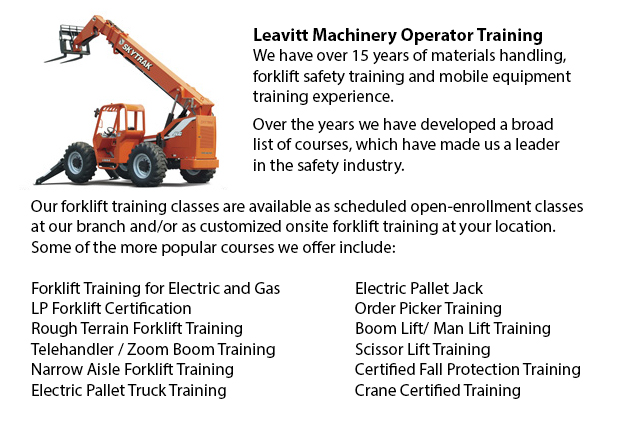
Barrie Zoom Boom Training - Zoom Boom Training is intended to train operators on variable reach forklifts. The goals of the training are to impart an understanding of the physics of the machine, and to be able to outline the operator's job. This program abides by North American safety standards for lift trucks. Zoom boom training and certification is available at our site or at the company's location, provided there are a few people training. Certification given upon successfully completing it is good for three years.
A telescopic handler (otherwise referred to as a telehandler) is similar in some ways to both a forklift and a crane. It is a versatile equipment designed together with a telescopic boom which could lift upwards and extend forward. A variety of attachments could be connected on the end of the boom, like for instance bucket, pallet forks, muck grab or lift table. It is popular in industry and agriculture settings.
The telehandler is a common utilized together with fork attachments in order to allow the transporting of loads. Telehandlers have the advantage of being able to reach those inaccessible places which cannot be reached by a common forklift. Telehandlers are capable of removing palletized loads from inside a trailer and placing them on places which are high such as rooftops. For certain applications, they can be more practical and efficient as opposed to a crane.
The disadvantage of the telehandler is its unsteadiness when lifting loads which are heavier. As the boom extends with a load, the unit becomes increasingly unstable. Counterweights in the rear help, but do not solve the problem. The lifting capacity rapidly decreases as the working radius increases. Various machinery come along with front outriggers which extend the lifting capacity whilst the machine is stationary.
A load chart helps the operator to determine whether a given load is very heavy. Factors such as load weight, boom angle and height are calculated. Various telehandlers have sensors which provide a warning or cut off further control if the unit is in danger of destabilizing.
-
Barrie Warehouse Forklift Safety Training
Barrie Warehouse Forklift Safety Training - Businesses normally face liability for injuries and damage sustained in workplace accidents. Warehouses can be hazardous places to the individuals who work there. That is the reason why employee safety is a... More -
Barrie Aerial Platform Training
Barrie Aerial Platform Training - Aerial lifts can accommodate many duties involving high and tricky reaching places. Normally used to carry out regular upkeep in buildings with high ceilings, prune tree branches, hoist heavy shelving units or mend p... More -
Barrie Forklift Ticket
Barrie Forklift Ticket - Pallet jacks and lift trucks are both intended for practically the same reason; to transfer goods from one location of your warehouse to another. This is basically where the comparison stops however. With the pallet jack, the... More -
Barrie Aerial Lift Training
Barrie Aerial Lift Training - An aerial work platform is a mechanized access platform. This machinery provides access to otherwise not accessible places for people or equipment. Also referred to as an aerial device or elevating work platform, the mac... More -
Barrie Aerial Boom Lift Training
Barrie Aerial Boom Lift Training - For people who operate or supervise the use of aerial lift platforms, correct aerial boom lift Training is required. The aerial lift platform is utilized for lifting individuals, tools and materials to elevated work... More -
Barrie Manlift Certification
Barrie Manlift Certification - The Elevated Platforms and Manlifts Certification program helps to provide the needed training on the work practices, safe operating procedures, rules and regulations regarding the everyday activities for the operators... More -
Barrie Overhead Crane Certification
Barrie Overhead Crane Certification - The overhead crane training certification course is designed to be effective with all participants regardless of literacy or language limitations. The course has two parts: a classroom training session and a prac... More -
Wheel and Track Loader Training in Barrie
Lift trucks are obtainable in several various units that have varying load capacities. The majority of typical lift trucks utilized in warehouse settings have load capacities of one to five tons. Bigger scale models are used for heavier loads, such a... More

Forklift Certification Barrie
TOLL FREE: 1-888-254-6157
Barrie, Ontario
forkliftcertificationbarrie.com
Email Us
About Us


